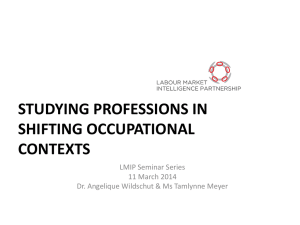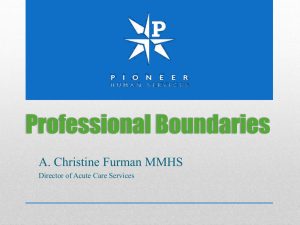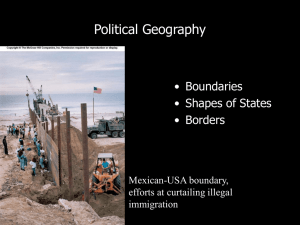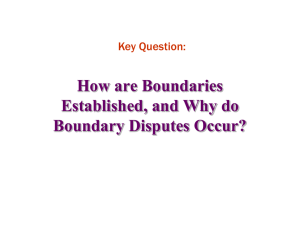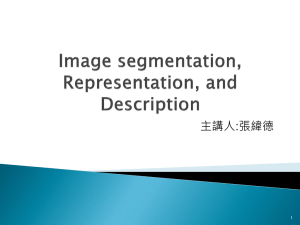Coincident Site Lattices (CSL) and grain boundaries
advertisement
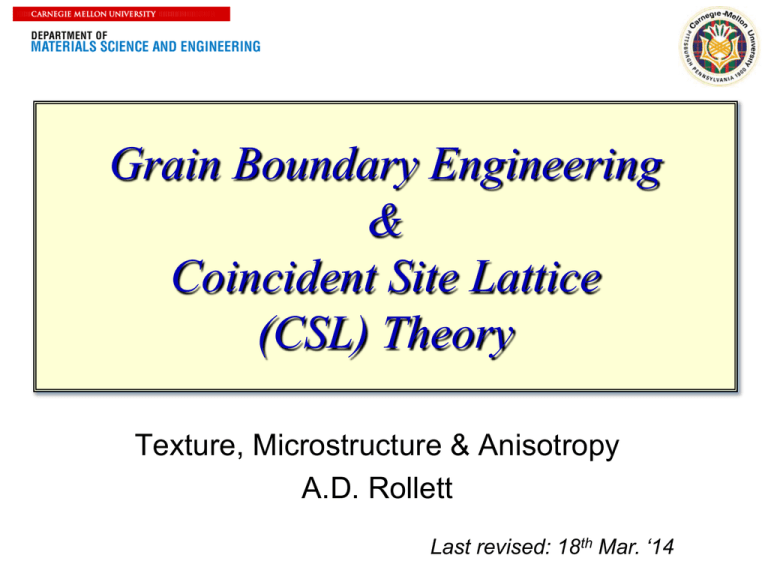
1
Grain Boundary Engineering
&
Coincident Site Lattice
(CSL) Theory
Texture, Microstructure & Anisotropy
A.D. Rollett
Last revised: 18th Mar. ‘14
2
Objectives
• The objectives of this lecture are:
• Develop an understanding of grain boundary
engineering
• Explain the theory of Coincident Site Lattices
(CSLs) and how it applies to grain boundaries
• Show how microstructures are analyzed for
CSL content
3
References
•
•
•
•
•
•
•
•
•
•
Interfaces in Crystalline Materials, Sutton & Balluffi, Oxford U.P., 1998. Very complete
compendium on interfaces.
Interfaces in Materials, J. Howe, Wiley, 1999. Useful general text at the upper
undergraduate/graduate level.
Crystal Defects and Crystalline Interfaces, W. Bollmann, (1970). New York, Springer Verlag.
Grain Boundary Migration in Metals, G. Gottstein and L. Shvindlerman, CRC Press, 1999.
The most complete review on grain boundary migration and mobility.
Materials Interfaces: Atomic-Level Structure & Properties, D. Wolf & S. Yip, Chapman &
Hall, 1992.
Bollmann, W. (1982), Crystal lattices, interfaces, matrices. Published by the author, Geneva.
Grimmer, H., Disorientations and coincidence rotations for cubic lattices. Acta Crystall. A30
(1974) 685–688.
Grimmer, H., Bollmann, W., Warrington, D. H., Coincidence- site lattices and complete
pattern-shift lattices in cubic crystals. Acta Cryst. A30 (1974) 197 – 207.
Bonnet, R., et al. (1981). Determination of near-Coincident Cells Hexagonal Crystals Related DSC Lattices. Acta Crystall. A37 184-189.
Ikuhara, Y. and P. Pirouz (1996). Orientation relationship in large mismatched bicrystals and
coincidence of reciprocal lattice points (CRLP). In: Intergranular and Interphase Boundaries
in Materials, Pt 1. 207 121-124.
4
Outline
• Slides from Integran with examples of Grain
Boundary Engineered materials
• CSL theory
• Brandon’s criterion for classification of grain
boundaries by CSL type
• Technical information on comparative
properties of GBE and non-GBE materials
5
Reading
• Pages 3-25 of Sutton & Balluffi
• Pages 307-346 of Howe.
6
Grain Boundary Engineering
• Grain Boundary Engineering (GBE) is the practice of obtaining
microstructures with a high fraction of boundaries with desirable
properties.
• In general, desirable properties are associated with boundaries
that have simple, low energy structures.
• Such low energy structures are, in turn, associated with CSL
boundaries.
• GBE generally consists of repeated cycles of deformation and
annealing, chosen so as to generate large fractions of “special
boundaries” and avoid development of strong recrystallization
textures.
• GBE is largely confined at present to fcc metallic systems such as
stainless steel, nickel alloys, Pb, Cu.
• Note that detailed information on exactly which CSL boundaries
have useful properties is lacking, as is information on how the
typical processing routes actually produce high fractions of CSL
boundaries.
7
Courtesy of:
Metallurgical Nano-Technology
Grain boundary engineering (GBE™)
is the methodology by which the local grain
boundary structure is characterized and material
processing variables adjusted to create an
optimized grain boundary microstructure for
improved material performance.
Nanocrystalline materials are those in
which the average crystal size is reduced 1000fold from the micron-range in conventional
materials to the nanometer size range (3100nm). This can be cost -effectively achieved
by proprietary electrodeposition techniques
(NanoPlate™).
8
GBE Technology
Grain boundary engineering (GBE™) is the
methodology by which the local grain boundary
structure is characterized and material
processing variables adjusted to create an
optimized grain boundary microstructure for
improved material performance.
Base Material
GBE Surface
Treatment
Patent-Protected Thermo-Mechanical Metallurgical
Process
Applied during component forming/fabrication processes.
Can also be applied as a surface treatment (0.1 to 1mm) to
finished or semi-finished structures.
• Increases Population of ‘Special’ Grain Boundaries
• Reduces Average Grain Size
Alloy 625
Special GB’s (red; yellow)
General GB’s (black)
• Enhances Microstructural Uniformity
• Fully Randomizes Crystallographic Texture
Integran’s GBE technology has also been applied to mitigate stress corrosion cracking
susceptibility of Ni-base alloys, extend the service-life of lead-acid battery grids, and improve
the fatigue and creep performance of aerospace superalloys.
10
Lead-Acid Batteries
Integran’s innovative GBE® grid processing technology is designed to
extend the service life of conventional SLI and industrial batteries (US
Patent No. 6,342,110 B1).
The cycle - life of lead-acid batteries (e.g.,
automotive) is compromised by intergranular
degradation processes (corrosion, cracking).
Conventional lead-acid
battery grid (Pb-1wt%Sb)
following 4 years of service.
Conventional
GBE
(fsp<15%) after
2 weeks of
cycling.
(fsp=55%) after
4 weeks of
cycling.
Palumbo, G. et al. (1998).
"Applications for grain
boundary engineered
materials." Journal of
Minerals, Metallurgy and
Materials (JOM) 50 40-43.
11
Corrosion of Aluminum 2124
• Results from experiment involving intergranular corrosion of
aluminum alloy 2124. Low angle boundaries are measurably
more resistant than high angle boundaries. Some evidence for
resistance of 3 and 7 boundaries (possibly also 3).
Research by Lisa Chan, CMU.
12
Corrosion in Ni
Alloy 600 (Ni-base alloy)
Several 3 boundaries with larger deviations from ideal
misorientation cracked.
Gertsman et al., Acta Mater., 49 (9): 1589-1598 (2001).
13
3 Boundaries
Ni3Al
Cracked 3 boundaries were found to deviate more than
5°from the trace of the {111} plane.
Lin et al., Acta Metall. Mater., 41 (2): 553-562 (1993).
13
14
Fatigue
Cycles to Failure
Room Temperature Fatigue Performance
of Selected Nickel Based Alloys
1200000
Conventional
1000000
GBE
800000
600000
400000
200000
0
Alloy 625/60ksi
Alloy 738/40ksi
Material/Stress
V57/40ksi
15
Creep
Thaveeprungsriporn, V. and G. S. Was (1997). "The role of coincidence-site-lattice boundaries in creep of Ni-16Cr-9Fe at 360
degrees C." Metallurgical And Materials Transactions A 28(10): 2101; Alexandreanu, B. et al. (2003). "The effect of grain boundary
character distribution on the high temperature deformation behavior of Ni-16Cr-9Fe alloys." Acta materialia 51 3831.
Alloy V57
Alloy 625
Conventional
GBE
16
Special Grain Boundaries
• There are some boundaries that have special properties, e.g.
low energy.
• In most known cases (but not all!), these boundaries are also
special with respect to their crystallography.
• When a finite fraction of lattice sites coincide between the two
lattices, then one can define a coincident site lattice (CSL).
• A boundary that contains a high density of lattice points in a
CSL is expected to have low energy because of good atomic fit.
• Note that the boundary plane matters, in addition to the
misorientation; this means, in effect, that only pure tilt or pure
twist boundaries are likely to have a high density of CSL lattice
points.
• Relevant website: http://www.tf.unikiel.de/matwis/amat/def_en/kap_7/illustr/a7_1_1.html (a page
from a general set of pages on defects in crystals:
http://www.tf.uni-kiel.de/matwis/amat/def_en/index.html ).
17
Grain Boundary properties
3 60°<111>
• For example,
fcc <110> tilt
boundaries show
pronounced
minima in energy
• However, some
caution needed
because the
<100> series do
not show these
minima.
11 50°<110>
Figure taken from Gottstein & Shvindlerman, based on Goux, C. (1974). “Structure des joints de grains:
consideration cristallographiques et methodes de calcul des structures.” Canadian Metallurgical Quarterly 13: 9-31.]
18
Kronberg & Wilson
• Kronberg & Wilson in 1947 considered coincidence
patterns for atoms in the boundary planes (as
opposed to the coincidence of lattice sites). Their
atomic coincidence patterns for 22° and 38°
rotations on the 111 plane correspond to the 13b
and 7 CSL boundary types. Note the significance of
coincidence in the plane of the boundary.
• Friedel also explored CSL-like structures in a study of
twins.
Kronberg, M. L. and F. H. Wilson (1949), “Secondary recrystallization in copper”, Trans. Met. Soc. AIME, 185,
501-514 (1947).
Friedel, G. (1926). Lecons de Cristallographie (2nd ed.). Blanchard, Paris.
19
Sigma=5,
36.9°
<100>
[Sutton & Balluffi]
20
CSL = geometrical concept
• The CSL is a geometrical construction based on the
geometry of the lattice.
• Lattices cannot actually overlap!
• If a (fixed) fraction of lattice sites are coincident, then
the expectation is that the boundary structure will be
more regular than a general boundary.
• Atomic positions are not accounted for in CSLs.
• It is possible to compute the density of coincident
sites in the plane of the boundary - this goes beyond
The basic CSL concept, which has to do only with the
lattice misorientation.
21
CSL construction
• The rotation of the second lattice is limited to
those values that bring a (lattice) point into
coincidence with a different point in the first
lattice.
• The geometry is such that the rotated point
(in the rotated lattice 2) and the
superimposed point (in the fixed lattice 1) are
related by a mirror plane in the unrotated
state.
22
Rotation to Coincidence
• Red and
Green lattices
coincide
Points to be
brought into
coincidence
23
rotating to the 5
relationship
24
rotating to the 5
relationship
25
rotating to the 5
relationship
26
rotating to the 5
relationship
27
rotating to the 5
relationship
28
rotating to the 5
relationship
29
rotating to the 5
relationship
30
rotating to the 5
relationship
31
rotating to the 5
relationship
32
5 relationship
Red and Green
lattices
coincide after
rotation of
2 tan-1 (1/3) =
36.9°
33
Rotation to achieve coincidence
• Rotate lattice 1
until a lattice
point in lattice 1
coincides with a
lattice point in
lattice 2.
• Clear that a
higher density of
points observed
for low index
axis.
[Bollmann, W. (1970). Crystal Defects and Crystalline
Interfaces. New York, Springer Verlag.]
34
CSL rotation angle
• The angle of rotation can be
determined from the lattice
geometry. The discrete nature
of the lattice means that the
angle is always determined as
follows.
y
q = 2 tan-1 (y/x),
where (x,y) are the coordinates
of the superimposed point (in 1);
x is measured parallel to the
mirror plane.
x
35
CSL <-> Rodrigues
• You can immediately relate the angle to a
Rodrigues vector because the tangent of the
semi-angle of rotation must be rational (a
fraction, y/x); thus the magnitude of the
corresponding Rodrigues vector must also be
rational!
• Example: for the 5 relationship, x=3 and
y=1; thus q = 2 tan-1 (y/x) = 2 tan-1 (1/3) =
36.9° and the rotation axis is [1,0,0], so the
complete Rodrigues vector = [1/3, 0, 0].
36
The Sigma value ()
• Define a quantity, ', as the ratio between the
area enclosed by a unit cell of the
coincidence sites, and the standard unit cell.
For the cubic case that whenever an even
number is obtained for ', there is a
coincidence lattice site in the center of the cell
which then means that the true area ratio, ,
is half of the apparent quantity. Therefore
is always odd in the cubic system.
37
Generating function
• Start with a square lattice. Assign
the coordinates of the coincident
points as (n,m)*: the new unit cell for
the coincidence site lattice is
square, each side is √(m2+n2) long.
Thus the area of the cell is m2+n2.
Correct for m2+n2 even: there is
another lattice point in the center of
the cell thereby dividing the area by
two.
• * n and m are identical to x and y
discussed in previous slides
38
Range of m,n
• Restrict the range of m and n such that m<n.
• If n=m then all points coincide, and m>n does not
produce any new lattices.
• Example of 5: m=1, n=3, area =(32+12) = 10; two
lattice points per cell, therefore volume ratio = 1:5;
rotation angle =2 tan-11/3 = 36.9°.
m
n
39
Generating function, contd.
• Generating function: we call the calculation
of the area a generating function.
(
) (
(
)
ì
2
2
2
2
ï0.5 m + n , m + n even
S=í
ï m2 + n 2, m2 + n2 odd
î
)
Sigma denotes the ratio of the volume of
coincidence site lattice to the regular lattice
40
Generating function: Rodrigues
• A rational Rodrigues vector can be generated
by the following expression, where {m,n,h,k,l}
are all integers, m<n.
r = m/n [h,k,l]
• The rotation angle is then:
tan q/2 = m/n (h2+k2+l2)
41
Sigma Values
• A further useful relationship for CSLs is that for
sigma. Consider the rotation in the (100) plane:
tan{q/2} = m/n
• area of CSL cell = m2+n2
= n2 (1 + (m/n)2) = n2 (1 + tan2{q/2})
• Extending this to the general case, we can write:
= n2 (1 + tan2{q/2}) =
n2 (1 + {m/n √(h2+k2+l2)}2) = n2 + m2(h2+k2+l2)
• Note that although using these formulas and inserting
low order integers generates most of the low order
CSLs, one must go to values of n~5 to obtain a
complete list.
[Ranganathan, S. (1966). “On the geometry of coincidence-site lattices.” Acta Crystallographica 21 197-199;
see also the Morawiec book, pp 142-149 for discussion of cubic and lower symmetry cases]
42
Quaternions
• Recall that all CSL relationships can be thought of as twin
relationships, which means that (in a centrosymmetric lattice) they can
be constructed as 180° rotations about some axis.
• Rotations of 180° have a very simple representation as a quaternion
(by contrast to Rodrigues vectors) because
cos(q/2)=cos(90°)=0 and sin(90°)=1. Therefore for a rotation axis of
[x,y,z] the unit quaternion = {x,y,z,0}.
• Take the 5 as an example. The rotation axis is [310], therefore the
quaternion representation is 1/√10{3,1,0,0}.
• Check that this is indeed the expected value by applying symmetry to
the ∆g and indeed one finds that this is equivalent to {1/3,0,0} as a
Rodrigues vector or 38.9°[100].
• One can further check that a vector of type [310] is mapped onto its
negative by using the quaternion to transform/rotate it. If we choose [1,3,0] as being orthogonal to the [310] access, we can use the
standard formula. PTO…
43
Quaternions, contd.
• Note that q0 = 0 in these cases (of 180° rotations) and q2=1, so
that simplifies the formula considerably:
s = -v + 2(v•q) q
= -v + 2(v•[310]) [310]
• Pick [-1,3,0] as an example:
= -v + 2([-1,3,0]•[3,1,0]) [3,1,0]
= -v + 2([-3+3+0]) [3,1,0]
= [+1,-3,0]
• Note that any value of the z coefficient will also satisfy the
relationship.
• Note that any combination of b=-3a in [a,b,c] (i.e. that has integer
coordinates to be a point in the lattice, and is perpendicular to
the axis) will also work. This helps to make the point that there
is an infinite set of points that coincide, each of which satisfies
the required relationship. That infinite set of coincident points is
the Coincident Site Lattice.
44
Table of
CSL values
in
axis/angle,
Euler
angles,
Rodrigues
vectors
and
quaternions
Note: in order to compare a
measured misorientation with
one of these values, it is
necessary to compute the
values to high precision
(because most are fractions
based on integers).
S
q (°)
3
5
7
9
11
13a
13b
15
17a
17b
19a
19b
21a
21b
23
25a
25b
27a
27b
29a
29b
31a
31b
33a
33b
33c
35a
35b
60
36.86
38.21
38.94
50.47
22.62
27.79
48.19
28.07
61.9
26.53
46.8
21.78
44.41
40.45
16.26
51.68
31.59
35.43
43.6
46.4
17.9
52.2
20.1
33.6
59.0
34.0
43.2
uv
w
111
100
111
110
110
100
111
210
100
221
110
111
111
211
311
100
331
110
210
100
221
111
211
110
311
110
211
331
f ,F,f
1
45
0
26.56
26.56
33.68
0
18.43
19.65
0
45
18.44
33.69
14.03
22.83
15.25
0
36.87
21.8
15.07
0
33.69
11.31
27.41
12.34
37.51
38.66
16.86
30.96
70.53
90
73.4
83.62
79.53
90
76.66
82.33
90
86.63
89.68
71.59
79.02
79.02
82.51
90
90
85.75
85.75
90
84.06
80.72
78.84
83.04
76.84
75.97
80.13
88.36
r
2
45
36.86
63.44
26.56
33.68
22.62
71.57
42.27
28.07
45
18.44
56.31
75.97
50.91
52.13
16.26
53.13
21.8
31.33
43.6
56.31
78.69
43.66
58.73
37.51
38.66
60.46
59.04
1/ 3
1/ 3
0.2
0.25
1/ 3
0.2
0.143
0.4
0.25
0.4
1/ 6
0.25
1/ 9
1/ 3
1/ 3
0.143
1/ 3
0.2
0.285
0.4
0.286
1/ 11
0.4
0.125
0.273
0.4
0.25
0.272
1/ 3
0.0
0.2
0.25
1/ 3
0.0
0.143
0.2
0.0
0.4
1/ 6
0.25
1/ 9
1/ 6
1/ 9
0.0
1/ 3
0.2
0.143
0.0
0.286
1/ 11
0.2
0.125
0.091
0.4
0.125
0.272
q
1/ 3
0.0
0.2
0.0
0.0
0.0
0.143
0.0
0.0
0.2
0.0
0.25
1/ 9
1/ 6
1/ 9
0.0
1/ 9
0.0
0.0
0.0
0.143
1/ 11
0.2
0.000
0.091
0.000
0.125
0.091
0.288
0.000
0.188
0.000
0.000
0.000
0.139
0.000
0.000
0.171
0.000
0.229
0.109
0.154
0.104
0.000
0.100
0.000
0.000
0.000
0.131
0.09
0.180
0.000
0.087
0.000
0.119
0.083
0.288
0.000
0.188
0.236
0.302
0.000
0.139
0.183
0.000
0.343
0.162
0.229
0.109
0.154
0.104
0.000
0.300
0.193
0.136
0.000
0.263
0.09
0.18
0.123
0.087
0.348
0.119
0.253
0.288
0.316
0.188
0.236
0.302
0.196
0.139
0.365
0.243
0.343
0.162
0.229
0.109
0.308
0.313
0.142
0.300
0.193
0.272
0.393
0.263
0.09
0.359
0.123
0.261
0.348
0.239
0.253
Note: integer fractions are quoted for most of the Rodrigues vectors. The entries in decimals also
correspond to integer values and will be updated at a later time.
0.866
0.948
0.944
0.943
0.904
0.981
0.971
0.913
0.970
0.858
0.973
0.918
0.982
0.926
0.938
0.99
0.9
0.962
0.953
0.928
0.919
0.988
0.898
0.985
0.957
0.870
0.956
0.93
45
CSL + boundary plane
• Good atomic fit at an interface is expected for boundaries that
intersect a high density of (coincident site) lattice points.
• How to determine these planes for a given CSL type?
• The coincident lattice is aligned such that one of its axes is
parallel to the misorientation axis. Therefore there are two
obvious choices of boundary plane to maximize the density of
CSL lattice points:
(a) a pure twist boundary with a normal // misorientation axis is
one example, e.g. (100) for any <100>-based CSL;
(b) a symmetric tilt boundary that lies perpendicular to the axis and
that bisects the rotation should also contain a high density of
points. Example: for 5, 36.9° about <001>, x=3, y=1, and so
the (310) plane corresponds to the 5 symmetric tilt boundary
plane [i.e. (n,m,0)].
46
CSL boundaries and RF space
• The coordinates of nearly all the low-sigma
CSLs are distributed along low index
directions, i.e. <100>, <110> and <111>.
Thus nearly all the CSL boundary types are
located on the edges of the space and are
therefore easily located.
• There are some CSLs on the 210, 331 and
221 directions, which are shown in the interior
of the space.
47
RF pyramid
and CSL
locations
R1+R2+R3=1
l=111
l=100
(√2-1,0)
(√2-1,√2-1)
l=110
48
Plan View:
Projection
on R3= 0
<110>,
<111>
<111> line
lies over the <110> line
<100>
33c
49
Fractions of CSL Boundaries in a
Randomly Oriented Microstructure
• It is interesting is to ask what fraction of boundaries
correspond to each sigma value in a randomly
oriented polycrystal?
• The method to calculate such (area) fractions is
exactly the same as for volume fractions in an
Orientation Distribution.
• The Brandon Criterion establishes the “capture
radius” for each sigma value (which decreases with
increasing sigma value).
• All points (in a discretized MD) are assigned to a
given CSL type if they fall within the capture radius.
50
CSL % for Random Texture
3
Pan
Morawiec
Garbacz
Gertsman
Plank
Tetrakaidecahedron
Percentages
2.5
2
1.5
1
0.5
0
1
3
5
7
9
11
13
15
17
19
21
23
25
27
29
CSL Boundary Type (-value)
Garbacz et al., Scr. Mater., 23 (8): 1369-1374 (1989).
Gertsman et al., Acta Metall. Mater., 42 (6): 1785-1804 (1994).
Morawiec et. al., Acta Metall. Mater., 41 (10): 2825-2832 (1993).
Pan et al., Scr. Metall. Mater., 30 (8): 1055-1060 (1994).
Generate MD from a random
texture; analyze for fraction near
each CSL type (method to be
discussed later).
Grain Boundaries from High Energy Diffraction Microscopy
Measurements made at the Advanced Photon Source:
see Hefferan et al. (2009). CMC 14 209-219.
Pure Nickel: 42 layers, 4 micron spacing, 0.16 mm3
Pure Ni sample, 42 layers
3,496 grains; ~ 23,598 GBs
Statistics extraction from large data sets
Neighbor
misorientation
angle
distribution
Hefferan et al. (2009). CMC 14 209-219.
Statistics extraction from large data sets
Neighbor
misorientation
angle distribution
Conclusion:
The misorientations
of grain boundaries
in these nickel
samples are
concentrated on a
small number of CSL
types, i.e. sigma =
3,7,9,11,27
Hefferan et al. (2009). CMC 14 209-219.
27a
27b
3
7
54
Brandon Criterion
•
David Brandon [ 1966: "The structure of high-angle grain boundaries”,
Acta metallurgica 14: 1479-1484] originated a criterion for proximity to a
CSL structure.
vm = v0-1/2
where the proportionality constant, v0, is generally taken to be 15°,
based on the low-to-high angle transition.
•
Larger sigma values imply larger unit cells in the boundary, fewer
coincident points, larger dislocation densities for the same deviation
from the exact CSL misorientation. Thus one has to closer to the exact
CSL position in order for a given boundary to be counted as belonging
to that CSL type.
•
Closeness to a misorientation type is defined by the angle associated
with the rotation between the misorientation in question, ∆g, and the
CSL misorientation, ∆gCSL.
cos(qm) = {trace(∆g ∆gTCSL)-1}/2
55
Impact of
the Brandon
Criterion
56
Brandon Criterion, contd.
• Thus, if:
qm < v0m-1/2 < 15°m-1/2
then we accept the
boundary as belonging
to the CSL of type =m.
• The justification is
based on the existence
of a dislocation structure for vicinal interfaces to
CSL structures, just as for low angle boundaries
[see fig. 2.33 from Sutton & Balluffi]. Typical
cutoff at =29.
57
How near to a CSL?
• A reasonable way to measure distance from
a special boundary type and an arbitrarily
specified boundary is to calculate a minimum
rotation angle (“orientation distance”) in
exactly the same way as for the
disorientation. In terms of Rodrigues vectors,
we write the following for the composition of
two rotations, r1r2, which represents r1
followed by r2:
58
Composition of Rodrigues vectors
r1 + r2 - r1 ´ r 2
r1 · r2 =
1- r1 × r 2
• To use this, we simply assign the components of a CSL
boundary type to one of the Rodrigues vectors (strictly speaking,
the inverse rotation, although the negative rotation is always
equivalent to the positive one.
rg.b. · (-rCSL ) =
•
rg.b. - rCSL + ( rg.b. ´ rCSL )
1+ ( rg.b. × rCSL )
As always, one must use the crystal symmetry operators in order to find
the smallest available angle. Unless both the CSL value and the
misorientation have been placed in the fundamental zone, then one will
obtain the wrong result.
59
Angle from CSL
One can then extract the angle, q, from the length of
the resultant vector (Chapter 3), where r is the
Rodrigues vector description of the boundary in
question and |r| is the rotation angle associated
with the vector:
q0 = |r • r000/0°| = |r • r|, r=(0,0,0)
q1 = |r • r111/60°| = |r • r3|, r3=(/3,/3,/3)
q3 = |r • r111/38.21°| , r7=(0.2,0.2,0.2)
60
Deviation from a CSL
• The deviation of a given misorientation from an exact
misorientation type, such as a CSL type, is found by forming the
product of the misorientation to be tested, and the inverse of the
reference type.
• Given a ∆g = (OBgB)(OAgA)-1, and a reference type, ∆gCSL, then
form the product
∆g’ = ∆g (∆gCSL)-1.
• As stated before, it is necessary to apply all the relevant (crystal)
symmetry operators (including the switching symmetry) to the ∆g
in order to ensure that the variant that is closest to the reference
type is included in the comparison. This means that the result
must be chosen that produces the minimum angle and that
places the misorientation axis in the fundamental zone.
• Given the product “mis-misorientation”, one usually only
considers the magnitude (rotation angle) extracted from it.
• All these operations can be performed with matrices, Rodrigues
vectors, or (unit) quaternions. Most serious software uses
quaternions.
61
Algorithm for Disorientation: 1
•
To find the disorientation*, as just an angle, associated with a grain
boundary but not identifying which symmetry operator was required for
each crystal:
1. Make a list of all crystal symmetry operators;
2. Loop over switching symmetry (2 passes), which computes both
∆gAB and ∆gBA ;
3. Loop over OA (24 different operators, for cubic xtal symmetry);
4. Calculate ∆g = gB (OAgA)-1 or (OAgA) gB-1 and extract the angle (e.g.
as arc-cosine of [trace(∆g)-1]/2), depending on the first loop;
5. If (misorientation) angle is lower than the previous result then
retain the result (as the current candidate for the disorientation);
6. End of loops: the misorientation that satisfied the tests is the
disorientation because it possesses the minimum rotation angle.
The misorientation axis can be placed in a single standard
stereographic triangle by making all the indices positive that are
associated with the minimum angle, and re-ordering so as to make
h≤k≤l, for example.
*Disorientation:= combination of minimum angle and axis located in the
fundamental zone
62
Algorithm for Disorientation: 2
•
To find the disorientation* associated with a grain boundary and identify which
symmetry operator on each crystal provided the disorientation (useful for
analyzing 5-parameter grain boundary character:
1. List all relevant symmetry operators;
2. Compute both ∆gAB and ∆gBA (for switching symmetry); first loop over
switching symmetry (2 passes);
3. Second loop over OA ;
4. Third loop over OB to calculate ∆g = (OBgB)(gAOA)-1 or (OAgA)(gBOB)-1 ,
depending on the first loop;
5. If (misorientation) rotation axis associated with ∆g lies within the
fundamental zone (e.g. 100-110-111 SST for cubic), then proceed to the
next test (treat the first such finding as a special case, i.e. retain the result
and do not apply the next test);
6. If (misorientation) angle is lower than the previous result then retain the
result (as the current candidate for the disorientation);
7. End of loops: the misorientation that satisfied the tests is the disorientation
because it lies within the fundamental zone and possesses the minimum
rotation angle.
8. For any subsequent calculations, e.g. of boundary normal, ensure that you
use the same symmetry operator in each grain as was found to yield the
disorientation.
*Disorientation:= combination of minimum angle and axis located in the
fundamental zone
63
Example: Effect of GBCD on Pb
Electrodes in Lead-Acid Batteries
Palumbo et al. [Palumbo, G., E. M. Lehockey, and P.
Lin (1998). “Applications for grain boundary
engineered materials.” JOM 50(2): 40-43.] have
shown that the crystallographic nature of grain
boundaries in Pb have a strong effect on the
resistance of Pb electrodes (in the form of latticework grids) to failure via intergranular corrosion and
creep-cracking. More specifically, Pb that has been
processed to have a high fraction of special
boundaries, i.e. coincidence site lattice boundaries
with low sigma numbers, exhibit significantly longer
lifetimes.
64
Pb electrodes, contd.
The figure (next slide) illustrates the difference
in performance for Pb-Ca-Sn-Ag lead-acid
positive battery grids following 40 chargedischarge cycles. The image on the left is
the as-cast material with 7% special
boundaries (3 29); the image on the
right is the grain boundary engineered
material with 67.6% special boundaries. The
small amount of Ca added to Pb is a
hardening agent (from the eutectic at 0.07%
Ca).
65
66
Example: creep resistance in
Inconel 600: Ni-16Cr-9Fe
• Creep resistance of Nialloys is strongly
enhanced by maximizing
the fraction of special
boundaries.
• Solution annealed (SA)
vs. CSL-enhanced
(CSLE): note higher
frequencies of low-
boundaries.
Was, G. S., V. Thaveepringsriporn, et al. (1998). “Grain boundary
misorientation effects on creep and cracking in Ni-based alloys.” JOM 50(2):
44-49.
67
Creep Resistance
Standard Material
Grain
Boundary
Engineered
• Constant load creep curves show dramatic
improvement in creep resistance from samples with
normal boundaries, and [grain boundary engineered]
GBE samples with a high fraction of CSL boundaries.
68
Creep Rates
• Creep resistance thought
to be enhanced by
resistance of CSL
boundaries to recovery of
extrinsic dislocations.
Lack of recovery in CSLs
means higher back
stresses opposing creep
stress, therefore lower
strain rate.
69
Mechanism
Dislocations (extrinsic
grain boundary
dislocations) accumulate
in CSL boundaries
giving rise to back
stresses that oppose
creep.
V. Thaveepringsriporn and Was, G. S. (1997). “The role of CSL
boundaries in creep of Ni-16Cr-9Fe at 360°C.” Metall. Trans. 28A: 2101.
70
Creep of Ni: model
• The creep rate as a
function of grain
size and boundary
type was modeled
(after Sangal &
Tangri) assuming
that dislocation
annihilation is much
slower in CSL
boundaries than in
general boundaries.
71
Grain Boundary
Cracking
Cracking at grain
boundaries in corrosion
testing post-creep shows
strong sensitivity to
boundary type: CSL
boundaries are less
prone to corrosion
attack.
V. Thaveepringsriporn and Was, G. S. (1997). “The role of CSL
boundaries in creep of Ni-16Cr-9Fe at 360°C.” Metall. Trans. 28A: 2101.
72
Grain Boundary Properties
•
•
•
•
•
Based on these remarks on grain boundary structure, one might
expect that CSL boundaries (especially in the pure twist or tilt
boundary alignment) would have low energy because of good atomic
fit.
Some observations support this, e.g. deposition of small particles on a
single crystal shows that low-sigma CSL boundaries are favored.
“Grain boundary engineering” relies on simply maximizing the (area)
fraction of CSL boundaries. This is typically made quantitative by
adopting Brandon’s criterion and counting the fraction of boundaries
that are associated with ≤29.
Observations of grain boundary character MgO [Saylor & Rohrer]
suggest otherwise: the low surface energy plane tends to dominate
the grain boundary distribution, and is associated with low boundary
energy in all crystalline materials.
It turns out that fcc metals are the exception because of their
exceptionally low coherent twin boundary energy, which, in Ni & Cu
(for example) is about 5% of the high angle GB energy. This
promotes the formation of annealing twins, which in turn result in
related CSL types being present such as 9, 27.
73
Summary
•
•
•
•
•
The Coincident Site Lattice is a useful concept for identifying
boundaries with low misfit (thus, low energy) in fcc metals.
Brandon’s criterion: Standard analysis of orientation distance leads to a
criterion for how close a given grain boundary is to a particular CSL
type. Brandon’s criterion provides a numerical measure that is based
on the concept of interfacial dislocations that accommodate small
departures from an exact CSL relationship.
Grain Boundary Engineering relies upon CSL analysis.
Macroscopic Degrees of Freedom: In general, five parameters needed
to describe crystallographic grain boundary character. This is apparent
in the combination of CSL misorientation relationship and twist or tilt
boundary plane (to maximize CSL point density in the boundary plane).
Caution: the CSL theory applies to lattice sites, not atom positions.
Evidence suggests strongly that in all except fcc metals, the properties
are related to the two surfaces that make up the boundary, not the CSL
structure. The existence of low energy boundaries for e.g., 3 and 11
boundaries is “coincidence”.
74
Supplemental Slides
• Information on CSL relationships in hcp
metals, courtesy of Nathalie Bozzolo,
CEMEF, France.
75
CSL list for HCP
Bozzolo et al. (2010). "Misorientations induced by deformation twinning in titanium." J. Appl. Crystallography 43 596-602
76
CSLs for HCP in RF space
1.
2.
Note the two
different
conventions for
alignment of the
orthonormal
coordinate system
(used for
calculations) with
the crystallographic
axes. Typically
Channel (HKL)
systems use the Yconvention whereas
EDAX (TSL/OIM)
systems use the Xconvention.
Certain CSL
relationships
correspond to
deformation twins
observed in Ti and
Zr.
, - . : ;<94=>? 237! @7: A49> 1 2=B23 C7<D7E79<3F>3=2<37G
) "4
54
) 64
) 68
! ) #$
) "4
54
) 64
! &#$
) "4
54
) 64
) 547777) " 877&" 87777) ) 8
) "4
54
) 64
) 547777) " 877&" 87777) ) 8
! ) #$
) ) 4777&" 477758777) " 9777) 69
) ) 4777&" 477758777) " 9777) 69
( ) ) *&$+
! " #$
"
7777)
) 54
"8
8 77&
( $) *) $+
)8
7777)
) 58
! " #$
) ) 4777&" 477758777) " 9777) 69
! &#$
) 68
5
4777
77&"
7
4
))
9
77) 6
" 97
)
7
7
87
) 58
( ) $*) $+
) 547777) " 877&" 87777) ) 8
( &*) *) $+
) 68
! " #$%&
! " #$%&
) 68
&" 9
&" 9
! " #$%&'
!" #$%" &" %' ()*+&, - . /0. 12- . *3(
! " #$%&'
!" #$4&" &" %' ()*5&, - . /0. 12- . *3(
, -.
, - . /01 23
Bozzolo et al. (2010). "Misorientations induced by deformation twinning in titanium." J. Appl. Crystallography 43 596-602

